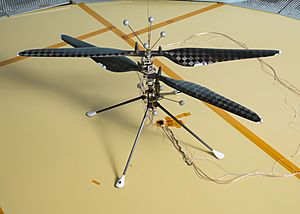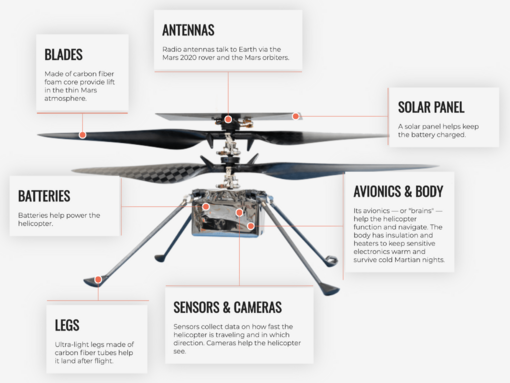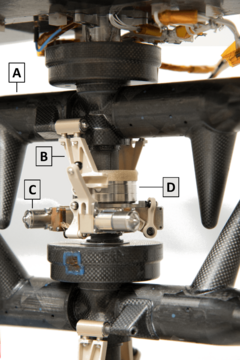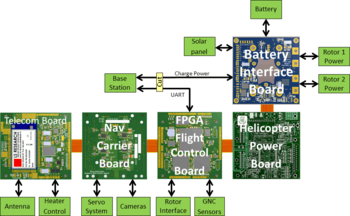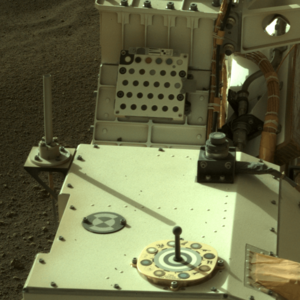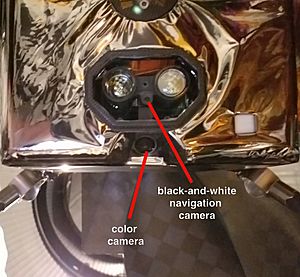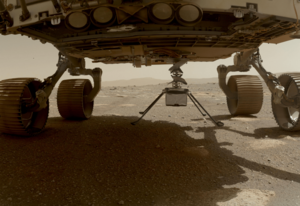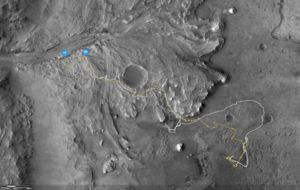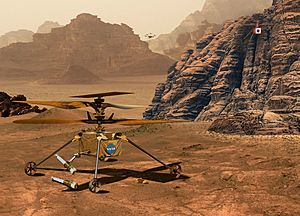Ingenuity (helicopter) facts for kids
Quick facts for kids Ingenuity |
|
|---|---|
| Part of Mars 2020 | |

Ingenuity at Wright Brothers Field on April 6, 2021, its third day of deployment on Mars
|
|
| Type | Extraterrestrial autonomous UAV helicopter |
| Manufacturer | Jet Propulsion Laboratory |
| Technical details | |
| Dimensions | 121 cm × 49 cm × 52 cm (48 in × 19 in × 20 in) |
| Dry mass | 1.8 kilograms (4.0 lb) |
| Power | 6 Solar-charged Sony VTC-4 Li ion batteries; typical engine input power: 350 watt |
| Flight history | |
| First flight | 19 April 2021, 07:34 UTC |
| Last flight | January 18, 2024 |
| Flights | 72 |
| Fate | Retired due to sustained rotor blade damage |
| Instruments | |
|
|
Ingenuity, also called Ginny, was a special helicopter that flew on the planet Mars. It was part of NASA's Mars 2020 mission. This helicopter was the first aircraft to make a powered, controlled flight on another planet.
Ingenuity arrived on Mars attached to the bottom of the Perseverance rover. It was set down on the Martian surface on April 3, 2021. Both the rover and the helicopter started their missions in Jezero crater. This crater is about 28 miles (45 km) wide.
The helicopter showed that it was possible to fly in Mars's very thin air. Mars's atmosphere is only about 0.6% as thick as Earth's air. This means it's much harder to get lift there. Ingenuity proved that flying on other planets is possible. It also showed that robots can fly on their own without constant human control. This is important because radio signals take 5 to 20 minutes to travel between Earth and Mars. So, Ingenuity had to fly by itself using plans sent by its operators.
Ingenuity was first meant to fly only five times over 30 Martian days (called sols). It would fly at low heights for up to 90 seconds. But it did much better than expected! After its first flights, it started helping the Perseverance rover. It scouted areas of interest for the rover. The helicopter flew for much longer than planned. On January 18, 2024, it was damaged during its 72nd flight. NASA then announced that Ingenuity was retired. It had flown for over two hours and traveled more than 10 miles (16 km).
Ingenuity was designed by NASA's Jet Propulsion Laboratory (JPL). Other groups like AeroVironment and NASA's research centers also helped.
Contents
How Ingenuity Was Made
Starting the Idea
The idea for Ingenuity began around 2012. Engineers at JPL thought about making a small helicopter to fly on Mars. By 2015, NASA decided to fund the creation of a full-size test model. This model helped them learn how to build the real helicopter.
In 2014, JPL and AeroVironment shared their design for a scout helicopter. By 2016, they asked for $15 million to keep working on it. By 2017, they tested models in special chambers that copied Mars's air. They also tested models in the Arctic.
Joining the Mars Mission
When the Mars 2020 mission was approved in 2014, a helicopter was not part of the plan. But in March 2018, the U.S. government gave $23 million for the helicopter project. On May 11, 2018, it was announced that the helicopter could be ready for the Mars 2020 mission.
The helicopter went through many tests. It was attached to the bottom of the Perseverance rover in August 2019. NASA spent about $80 million to build Ingenuity. It cost about $5 million to operate it.
Engineers tested Ingenuity in a large vacuum chamber. This chamber simulated the very thin air of Mars. It was filled with carbon dioxide to match Mars's atmosphere. This is like flying at 34,000 meters (111,500 feet) high on Earth. To copy Mars's weaker gravity (about one-third of Earth's), a line pulled the helicopter upwards during tests. A "wind-wall" with almost 900 fans created wind in the chamber.
In April 2020, an 11th-grade girl named Vaneeza Rupani named the vehicle Ingenuity. She submitted an essay to NASA's "Name the Rover" contest. The helicopter was also nicknamed Ginny. Its test model on Earth was called Earth Copter or Terry.
Ingenuity was designed to be a "technology demonstrator." This means its main goal was to see if a helicopter could fly safely on Mars. Scientists hoped helicopters could help future rovers. They could map areas and find safe paths. This could help rovers travel much farther each day.
The Team Behind Ingenuity
The team that built Ingenuity was quite small. It had about 65 full-time people from JPL. Other workers from AeroVironment and NASA research centers brought the total to 150.
Some key people on the team included:
- MiMi Aung – Project Manager
- Bob Balaram – Chief Engineer
- Håvard Fjær Grip – Chief Pilot
The Ingenuity team won important awards. In 2021, they received the John L. "Jack" Swigert Jr. Award for Space Exploration. In 2022, they won the Collier Trophy. This award is for the greatest achievement in American aviation or space travel.
How Ingenuity Was Built
Parts of the Helicopter
Ingenuity had a rectangular body. It measured about 136 x 195 x 163 mm (5.4 x 7.7 x 6.4 inches). Below the body were two main rotors that spun in opposite directions. These rotors were about 1.21 meters (4 feet) wide. The helicopter also had four landing legs, each 384 mm (15 inches) long. A solar panel on top of the rotors recharged its batteries. The whole helicopter was 0.49 meters (1.6 feet) tall.
Mars has much weaker gravity than Earth. But its air is also very thin. This makes it hard for an aircraft to get enough lift. Mars's air is about 100 times thinner than Earth's air at sea level. To fly, Ingenuity's special blades had to spin very fast. They spun between 2400 and 2900 rpm. This is about 10 times faster than a helicopter on Earth.
Each of the helicopter's rotors was controlled by a special part called a swashplate. This allowed the helicopter to move up, down, and sideways. Even though it was an aircraft, it was built strong like a spacecraft. This helped it survive the launch to Mars.
Electronics and Power
Ingenuity used different sensors to fly. These sensors were standard parts, like those found in cellphones. One sensor, an Inertial measurement unit (IMU), helped it know its position and movement. Another sensor, a laser altimeter, measured its height above the ground.
The helicopter had a solar panel to charge its batteries. It used six Sony Li-ion batteries. These batteries could store about 35 to 40 Wh of energy. The helicopter's flight time was limited by how hot its motors got, not by battery power.
Ingenuity used a Qualcomm Snapdragon 801 processor. It ran on a Linux operating system. This processor helped control the helicopter's navigation. It tracked features on the ground using a camera. The processor was connected to special radiation-resistant microcontrollers. These helped it fly in Mars's harsh conditions.
For communication, Ingenuity had two radios and antennas. It used Zigbee technology to talk to the Perseverance rover. This allowed it to send data at 250 kbit/s over distances up to 1000 meters (3,280 feet). The antenna on the solar panel weighed only 4 grams.
Cameras and Photos
Ingenuity had two cameras. One was a high-resolution color camera (RTE camera). The other was a lower-resolution black-and-white navigation camera (NAV camera).
Unlike Perseverance, Ingenuity did not have a special camera for 3D pictures. But it could create 3D images. It did this by taking two color photos from slightly different spots while hovering.
The NAV camera was very important for flights. It took pictures continuously to help the helicopter know its position and movement. The RTE color camera was not needed for flying, but it took amazing pictures of Mars. Only a few images could be sent back to Earth from each flight. The rest were discarded.
As of December 16, 2021, over 2000 black-and-white images and 100 color images from Ingenuity had been shared.
Flight Software
Ingenuity flew using autonomous control. This means it flew by itself. But its flights were planned and scripted by operators at Jet Propulsion Laboratory (JPL). It talked to the Perseverance rover before and after each landing.
The helicopter's flight software could be updated from Earth. This helped fix problems and add new features. For example, an update before flight 34 helped it avoid dangers when landing. It also fixed navigation errors when flying over bumpy ground. This was important as the helicopter moved away from flat areas.
Key Flight Details
| Rotor speed | 2400–2700 rpm |
| Originally planned flights | 1 to 5 flights within 30 Martian days |
| Flight time | Up to 167 seconds per flight |
| Maximum flight distance | 704 m (2,310 ft) (2,310 feet) |
| Maximum radio range | 1,000 m (3,300 ft) (3,280 feet) |
| Maximum height | 12 m (39 ft) (39 feet) |
| Maximum speed |
|
| Battery capacity | 35–40 Wh (130–140 kJ) |
Ingenuity's Journey on Mars
First Flights
Perseverance dropped the shield protecting Ingenuity on March 21, 2021. The helicopter was then lowered to the Martian surface on April 3, 2021. On that day, its cameras took their first photos of Jezero Crater. After deployment, the rover drove about 100 meters (328 feet) away. This gave Ingenuity a safe space to fly.
On April 8, 2021, Ingenuity's rotor blades were successfully unlocked. It then did a low-speed spin test at 50 rpm. A high-speed test failed at first due to a software issue. But JPL found a fix.
On April 16, 2021, Ingenuity successfully spun its rotors at full speed (2400 rpm) while on the ground. Three days later, on April 19, JPL flew the helicopter for the very first time. This was a historic moment! The software problem happened again for the fourth flight, but it was fixed. On June 25, JPL uploaded a permanent software update.
Each flight was planned to be 3 to 5 meters (10 to 16 feet) high. But Ingenuity soon flew higher. The first flight hovered at 3 meters (10 feet) for about 40 seconds. It even took a picture of the rover. The flights became more daring as the mission went on.
After the first three successful flights, the mission changed. It went from just showing technology works to showing how it can help. Ingenuity then started its "operations demonstration phase."
Helping the Rover
On April 30, 2021, NASA decided to keep Ingenuity flying. It would now help the Perseverance rover by scouting the terrain. Funding for Ingenuity was renewed each month.
Starting with its 6th flight, Ingenuity began mapping and scouting for the rover. The helicopter would help Perseverance more. In return, the rover would take fewer pictures of the helicopter flying. Taking photos took a lot of time and slowed down the rover's main mission. On May 7, Ingenuity successfully flew to a new landing spot.
After 12 flights by September 2021, the mission was extended without a set end date. After 21 flights by March 2022, NASA said it would keep flying Ingenuity. The helicopter was now flying over rougher areas. This included jagged cliffs and large rocks. Ingenuity helped the team decide the best path for Perseverance. It also helped find good places for science.
Software updates removed the helicopter's 50-foot (15-meter) height limit. They also allowed it to change speed in flight. NASA leaders were amazed by what Ingenuity could do. They said it was a huge step in space exploration.
The Ingenuity team planned to fly the helicopter every two to three weeks. As Mars entered its winter, the air got even thinner. The team prepared by testing faster rotor speeds. They needed to spin the blades at 2700 rpm for enough lift. This faster speed brought new risks like vibration.
Ingenuity also faced challenges during Martian winter and solar conjunction. Solar conjunction is when Mars moves behind the Sun. This blocks communication with Earth. The rover and helicopter had to stop operations. This happened in mid-October 2021. Ingenuity stayed still and sent weekly updates to the rover. It survived the solar conjunction. NASA decided to keep flying it because of the valuable information it provided.
Flight times were chosen based on battery temperature. The batteries needed to warm up after the cold Martian night. During Martian summer, the thinner air made the motors work harder. So, flights were moved to the morning and limited to 130 seconds. This prevented the motors from overheating.
In May 2022, Ingenuity unexpectedly lost contact with the rover. This happened after its 28th flight. JPL found that the batteries lost power overnight. This was likely due to more dust in the air, which reduced sunlight on the solar panel. Also, winter was approaching, bringing lower temperatures. Contact was re-established. Controllers decided to turn off the helicopter's heaters at night. This saved power, even though it risked exposing parts to extreme cold.
In June 2022, Ingenuity's inclination sensor stopped working. This sensor helped it know its angle before flight. Mission controllers found a way around this using another sensor.
By January 2023, Mars spring began. Ingenuity started getting enough solar power to avoid power issues. This meant it could fly more often and farther.
In March 2023, the helicopter flew often to deal with limited radio range. The Jezero delta had narrow canyons. Ingenuity needed to stay ahead of the rover.
Sometimes, mission controllers lost contact with Ingenuity. This happened when it flew out of sight of Perseverance. After its 49th flight in April 2023, JPL lost contact for six days. Perseverance had to drive to a spot to reconnect. Contact was lost again for 63 days after flight 52. Controllers had flown Ingenuity out of range on purpose. But the rover's plans changed, causing a longer delay. Contact was finally re-established on June 28.
Communication with Ingenuity was lost again after its 72nd flight on January 18, 2024. JPL got contact back on January 20. However, pictures showed that one or more rotor blades were damaged during landing. This meant it could not fly anymore. On January 25, 2024, NASA announced the end of the Ingenuity mission. The team planned to test its systems and download any remaining data.
Future Mars Helicopters
There are ideas for new helicopters on Mars.
Sample Return Helicopters
Engineers who created Ingenuity have proposed a new helicopter. This one could carry a small robotic arm and gripper. It could pick up sample tubes collected by Perseverance. NASA plans to use two of these helicopters.
Ingenuity's design was very safe. This makes it a good model for future helicopters. These new helicopters could carry small items and move them to different places.
One challenge for Ingenuity was accurate navigation. Future helicopters need to follow paths precisely and land exactly where they took off. This is important for picking up samples. Mars's thin air makes it hard to use Earth-like landing methods.
Mars Science Helicopter
Data from Ingenuity will help build future helicopters. These new helicopters will be able to carry heavier science tools (0.5kg - 2kg). The Mars Science Helicopter (MSH) is the next step. It will use many of Ingenuity's technologies. But it will also have new abilities. This will allow it to explore more of Mars.
The goal is to show how science tools can be carried and used by helicopters. This will open up new ways to explore Mars. The focus will be on:
- Helicopters that can carry and drop off science tools.
- New technologies for electronics, batteries, and navigation.
- Testing on Earth to make sure everything works.
MAGGIE
The Mars Aerial and Ground Intelligent Explorer (MAGGIE) is another idea. It's a compact, fixed-wing aircraft. It would fly in Mars's atmosphere using solar power. It could also take off and land vertically. MAGGIE would fly very efficiently. It could cover 179 km (111 miles) per 7.6 Martian days. Its total range per Martian year could be 16,048 km (9,972 miles).
MAGGIE could study Mars's atmosphere and geology. For example, it could look at magnetic fields in impact basins. It could also map underground water ice. This type of aircraft would greatly improve our ability to explore Mars. Ingenuity showed how exciting airborne missions on Mars can be. MAGGIE would be just as exciting.
Tributes to the Wright Brothers
NASA and JPL called Ingenuity's first flight on Mars their "Wright Brothers moment." This is like the first successful airplane flight on Earth by the Wright brothers. A small piece of fabric from the Wright brothers' 1903 Wright Flyer is attached to Ingenuity. In 1969, Apollo 11 astronaut Neil Armstrong carried a similar piece of fabric to the Moon.
NASA named Ingenuity's first take-off and landing spot Wright Brothers Field. The international aviation agency (ICAO) gave it an airport code of JZRO. They also gave Ingenuity a type designator of IGY and a call-sign of INGENUITY.
See also
 In Spanish: Mars Helicopter Ingenuity para niños
In Spanish: Mars Helicopter Ingenuity para niños
- ARES
- Atmosphere of Mars – Mars's air is very thin and mostly carbon dioxide.
- Coaxial rotors
- Dragonfly – A robotic helicopter mission to Saturn's moon Titan.
- Exploration of Mars
- List of artificial objects on Mars
- List of firsts in aviation
- Sky-Sailor
- Solar panels on spacecraft
- Vega – A Soviet space program that included the first balloon flight on Venus.
- Collier Trophy – An award given to the Ingenuity team in 2022.


